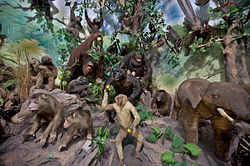
Back Taksidermie Afrikaans تحنيط الحيوانات Arabic Taksidermiya Azerbaijani Таксідэрмія Byelorussian Препариране Bulgarian Plouzer krec'hin Breton Taxidèrmia Catalan Preparace Czech Tacsidermi Welsh Taksidermi Danish

Taxidermy is the art of preserving an animal's body by mounting (over an armature) or stuffing, for the purpose of display or study. Animals are often, but not always, portrayed in a lifelike state. The word taxidermy describes the process of preserving the animal, but the word is also used to describe the end product, which are called taxidermy mounts or referred to simply as "taxidermy".[1]
The word taxidermy is derived from the Ancient Greek words τάξις taxis (order, arrangement) and δέρμα derma (skin).[2] Thus taxidermy translates to "arrangement of skin".[2]
Taxidermy is practiced primarily on vertebrates[3] (mammals, birds, fish, reptiles, and less commonly on amphibians) but can also be done to larger insects and arachnids[4] under some circumstances. Taxidermy takes on a number of forms and purposes including hunting trophies and natural history museum displays. Unlike meat harvesting, taxidermy does not require killing an animal that could have otherwise remained alive. Museums use taxidermy as a method to record species, including those that are extinct and threatened,[5] in the form of study skins and life-size mounts. Taxidermy is sometimes also used as a means to memorialize pets.[6]
A person who practices taxidermy is called a taxidermist. They may practice professionally, catering to museums and sportspeople (hunters and fishers), or as amateurs (hobbyists). A taxidermist is aided by familiarity with anatomy, sculpture, painting, and tanning.
- ^ "Learning to Look: Taxidermy in Museums – MSU Museum". Archived from the original on 2023-12-16. Retrieved 2023-10-10.
- ^ a b Harper, Douglas. "taxidermy". Online Etymology Dictionary. Retrieved 17 July 2010.
- ^ Stephen P. Rogers; Mary Ann Schmidt; Thomas Gütebier (1989). An Annotated Bibliography on Preparation, Taxidermy, and Collection Management of Vertebrates with Emphasis on Birds. Carnegie Museum of Natural History. ISBN 978-0-911239-32-4.
- ^ Daniel Carter Beard (1890). The American Boys Handy Book. C. Scribner's Sons. pp. 242, 243.
- ^ "Life After Death: Extinct Animals Immortalized With Taxidermy". National Geographic. Archived from the original on 2015-07-16. Retrieved 2015-07-16.
- ^ Pierce, Jessica (January 5, 2012). "Would You Like Your Pet Stuffed, Freeze-dried, or Cryonically Preserved?". Psychology Today. Sussex Publishers, LLC. Retrieved 2 March 2017.